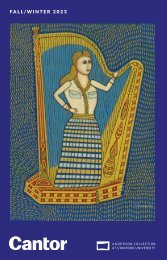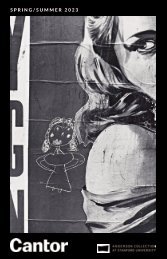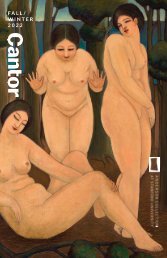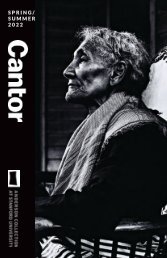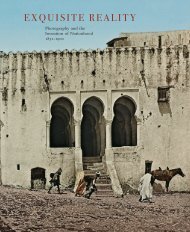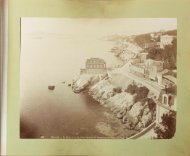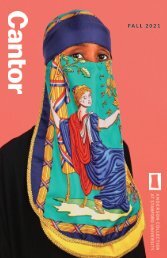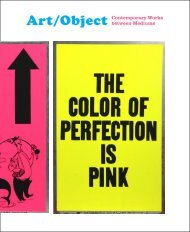Gallery Guide | The Melancholy Museum
Using over 700 items from the Stanford Family Collections, artist Mark Dion’s exhibition "The Melancholy Museum" explores how Leland Stanford Jr.’s death at age 15 led to the creation of a museum, university, and—by extension—the entire Silicon Valley.
Using over 700 items from the Stanford Family Collections, artist Mark Dion’s exhibition "The Melancholy Museum" explores how Leland Stanford Jr.’s death at age 15 led to the creation of a museum, university, and—by extension—the entire Silicon Valley.
You also want an ePaper? Increase the reach of your titles
YUMPU automatically turns print PDFs into web optimized ePapers that Google loves.
ut remained well connected: a<br />
congressman’s son-in-law who routinely<br />
worked for the rich, which sometimes<br />
involved concealing evidence and lying.<br />
Callundan and the police questioned the<br />
servants. Bertha appeared to implicate<br />
Ah Wing, who had been in the Stanfords’<br />
employ for years. <strong>The</strong> newspapers<br />
suspected a British-born maid and the<br />
Death Mask of Jane Lathrop butler. Reporters wrote that the police were<br />
Stanford, 1905. Stanford about to make arrests. <strong>The</strong>y never did.<br />
University Archives<br />
Bertha was the only person present<br />
at both poisonings. Before departing<br />
for Hawaii, she brought the bottle later found to contain strychnine to<br />
a Palo Alto pharmacy to be filled with bicarbonate of soda. Bertha’s<br />
brother proclaimed her innocence, even though at the time no one had<br />
actually accused her. Her mother supposedly told reporters that she<br />
knew who the murderer was, yet she never revealed the name.<br />
<strong>The</strong>re was no real police investigation following the second<br />
poisoning. Before departing for Hawaii to claim Jane’s body, David<br />
Starr Jordan and Timothy Hopkins, the latter a university trustee and<br />
family friend, told the press that strychnine was not the cause of death,<br />
insisting that Jane died of natural causes. <strong>The</strong> sheriff in Honolulu<br />
washed his hands of the case, saying that it belonged to the San<br />
Francisco police. At Callundan’s urging, the police accepted Jordan’s<br />
version of events and dropped the investigation. <strong>The</strong> police apparently<br />
did not know that Jane had been planning to dismiss both Jordan and<br />
Hopkins when she returned to San Francisco.<br />
<strong>The</strong> 1906 earthquake destroyed the San Francisco police records.<br />
<strong>The</strong> president of the board of trustees, Samuel Leib, destroyed<br />
most of his correspondence with Jane around the time of her death.<br />
Those who knew of Jane’s fears and her intention to fire Jordan and<br />
Hopkins said nothing. University officials gave Jane a lavish funeral in<br />
Memorial Church. <strong>The</strong>y instructed the ministers giving the eulogies<br />
not to mention the poisonings. Jordan famously celebrated Jane<br />
Stanford as “a good woman.” His indifference to her vision for the<br />
museum, coupled with budgetary problems and tough decisions about<br />
rebuilding after the 1906 earthquake, all but ensured the neglect of the<br />
museum so important to Jane Stanford and the memory of her son.<br />
<strong>The</strong> 1906 and 1989 Earthquakes<br />
ANNA TOLEDANO<br />
PhD candidate, History of Science<br />
IN THE EARLY MORNING OF APRIL 18, 1906, THE GREAT SAN FRANCISCO<br />
earthquake caused earth-shattering damage to the young Stanford<br />
University campus. <strong>The</strong> Main Quadrangle, the architectural dream of<br />
Leland Stanford Sr., emerged largely unscathed. <strong>The</strong> Leland Stanford<br />
Junior <strong>Museum</strong>, however, was not so lucky. While the reinforced<br />
concrete and steel-girded main section—the first large building of<br />
its kind—remained intact, the brick additions that Jane Stanford added<br />
after Leland Sr.’s death to house the ever-growing collection were<br />
decimated.<br />
B. E. Jenney, Stanford Room in the Stanford University <strong>Museum</strong>, 1906.<br />
Stanford University Archives<br />
44<br />
45




